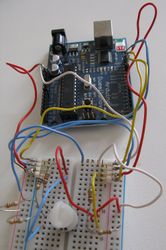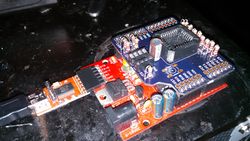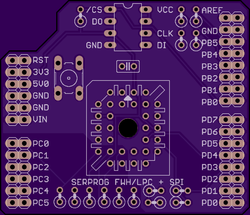Serprog/Arduino flasher
This wiki is retired
Our website is https://www.flashrom.org, instructions on how to add or update documentation are here
All wiki content available in read-only mode at wiki.flashrom.org
Hardware basics
You'll need to have a supported Arduino, which as of writing are any based on the ATmega328 (/168/88 will work with small changes too), like the Arduino Uno R3. Best performance is available with one with an FTDI usb-serial chip (older ones, sparkfun redboard, etc).
And unless the Arduino is a 3.3V version (rare, and the firmware would need small modifications (like MCU frequency) to run on one), you'll also need a way to convert the 5V logic levels to 3.3V, but check that your flash chip is 3.3V and not 1.8V - that would need level conversion in both directions and is not explained here, yet.
And an SPI flash chip that is supported by flashrom.
There will be some simple schematics included here. The idea is that you pick one version from each part 1 through 3, and connect the pin/net names.
Part 1: The Arduino
ATmega328 based ones:
Part 2: Level translation
There are a few options here, ranging from the simple resistors (v1) to a buffer chip (v3).
Here's the simple resistors:
The part count for the resistor divider is 6 resistors of 2 types or 9 of one type.
Here's one with 5 resistors, the downside is that you'll need to modify the firmware a little:
The 3rd version is using the DIP16 HEF4050 buffer chip:
Part 3: The SPI Flash chip
The smaller DIL-8 and SOIC-8 versions connect like this:
Gallery of some flashers
Alternative: Shield with SPI and LPC/FWH for 5V Arduinos
Firmware and hardware sources Shield PCB shared at oshpark
- This shield and firmware was built for 5V arduinos with FTDI, variations to that will need adaptations in building the shield and/or in the firmware.
- This shield uses a different pin for SPI CS than the other circuits on this page, and has LPC/FWH capability, thus different firmware.
- Note: do check for any incompatibilities between your arduino and the shield, eg. the PD7 used as LPC CLK clashes with BT reset in BT arduinos.
- For LPC/FWH, current (15/03/25) flashrom trunk will not work, until that is fixed use this branch instead.
Compatibility, software and setup
Compatibility
There are some differences between the various arduinos that are relevant for this flasher:
Architecture
- Only the AVR architecture is supported for now, because the code depends on avr-libc. In one hand that makes it portable across other non-arduino AVR boards, but it also makes it incompatible with the arduinos that don't have an AVR.
USB<->serial converter
- Some Arduinos have an FTDI USB<->Serial converter, we can achieve a very high speed of 2000000 bauds with ir.
- Some Arduino have a 8u2/16u2 instead: This is an extra microcontroller which does the USB<->serial conversion trough a firmware build on LUFA. While that brings lower cost and more flexibility, the downside is that in our case the default firmware was not written for speed over 115200. To get more speed we would need to write another firmware for it.
- Some Arduinos don't have an USB<->serial converter, like the arduino leonardo. Instead they have a native USB port.
- Most/All Arduinos have an accessible serial port on their pins. if you have an extra USB<->Serial converter, you can plug it to theses pins. BE SURE TO CHECK THE VOLTAGE COMPATIBILITY BEFORE ATTEMPTING THAT.
Voltage
- Some arduinos are at 3.3v.
- Some are at 5v. Unfortunately most SPI chips are at 3.3v at the time of writing.
Boards
| Arduinos | Hardware | User notes |
|---|---|---|
|
|
|
|
|
|
|
|
|
|
|
|
Setup
Required software
To make it work you need:
- A recent flashrom with the serprog protocol compiled in (most packaged versions do)
- frser-duino which runs on the arduino
- This page used to link to serprog-duino, frser-duino should build in a similar fashion and has better serial buffering and some other features (spi speed setting).
- The avr toolchain(avr-gcc, avr-libc,make etc...)
Building the software
First get the firmware source:
$ git clone --recursive git://github.com/urjaman/frser-duino $ cd frser-duino
Then build it:
For a board with a 8u2 or a 16u2:
$ make u2 && make flash-u2
For a board with an ftdi:
$ make ftdi && make flash-ftdi
Running flashrom
The right flashrom arguments are explained in the README.md, or here:
Available targets: ftdi, flash-ftdi: For the Arduinos with an FTDI compatible flashrom arguments: flashrom -p serprog:dev=/dev/ttyUSB0:2000000 Other boards using an hardware USB<->Serial converter might work too. u2, flash-u2: For the Arduino with a 8u2 or a 16u2 compatible flashrom arguments: flashrom -p serprog:dev=/dev/ttyACM0:115200
So for a board that has an ftdi that would give:
flashrom -p serprog:dev=/dev/ttyUSB0:2000000
Speed
The speed is very dependant on the flash chip used:
- Its capacity impacts the speed a lot, as you would expect.
- The chip model as also a huge impact.
Duemillanove
With the duemillanove:
# time flashrom -p serprog:dev=/dev/ttyUSB0:2000000 -r duemillanove.rom flashrom v0.9.7-r1711 on Linux 3.18.3-gnu-1 (i686) flashrom is free software, get the source code at http://www.flashrom.org Calibrating delay loop... delay loop is unreliable, trying to continue OK. serprog: Programmer name is "serprog-duino" Found Winbond flash chip "W25Q32.V" (4096 kB, SPI) on serprog. Reading flash... done. flashrom -p serprog:dev=/dev/ttyUSB0:2000000 -r duemillanove.rom
we have:
4.23s user 0.29s system 8% cpu 56.010 total
Uno
With the Arduino uno:
# flashrom -p serprog:dev=/dev/ttyACM0:115200 -r uno.rom flashrom v0.9.7-r1711 on Linux 3.18.3-gnu-1 (i686) flashrom is free software, get the source code at http://www.flashrom.org Calibrating delay loop... delay loop is unreliable, trying to continue OK. serprog: Programmer name is "serprog-duino" Found Winbond flash chip "W25Q32.V" (4096 kB, SPI) on serprog. Reading flash... done. flashrom -p serprog:dev=/dev/ttyACM0:115200 -r uno.rom
we have:
4.77s user 0.65s system 1% cpu 6:02.43 total
Tested chips
- SST25VF016B => huge issues, not recognized by the 3.3v version, had to use the 5v version which is over maximum allowed voltage, also had to lower the serial speed to 115200, ultra slow to write(seem related to the chip itself, since that with the openmoko programmer it's even slower...)...
- W25X80 works well in 3.3v mode(5v works also but it's highly not advised to use 5v)
Advantages and disadvantages
The speed isn't that great(about 3 minutes for reading+writing+verifying a 1M chip)Fixed by by Sebastian Parborg.Voltage issues( SPI levels are at 5v, it's problematic for flashing 3.3v chips...)- it is made of very commonly available parts(if you can find an arduino uno, you will be able to build it).
TODO
Find a way to lower the voltage to 3.3vFix the arduino UNO speed and reliability issuesSimply lowering the bauds as advised on the LUFA mailing list long time did fixed it.- Write a faster 8u2 firmware
- Look at other AVR targets
- Look if it's portable to other architectures (like ARM).







